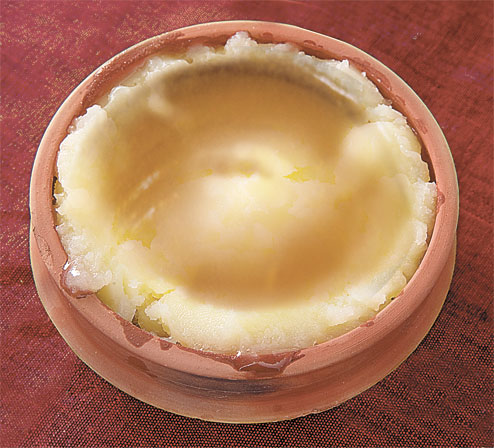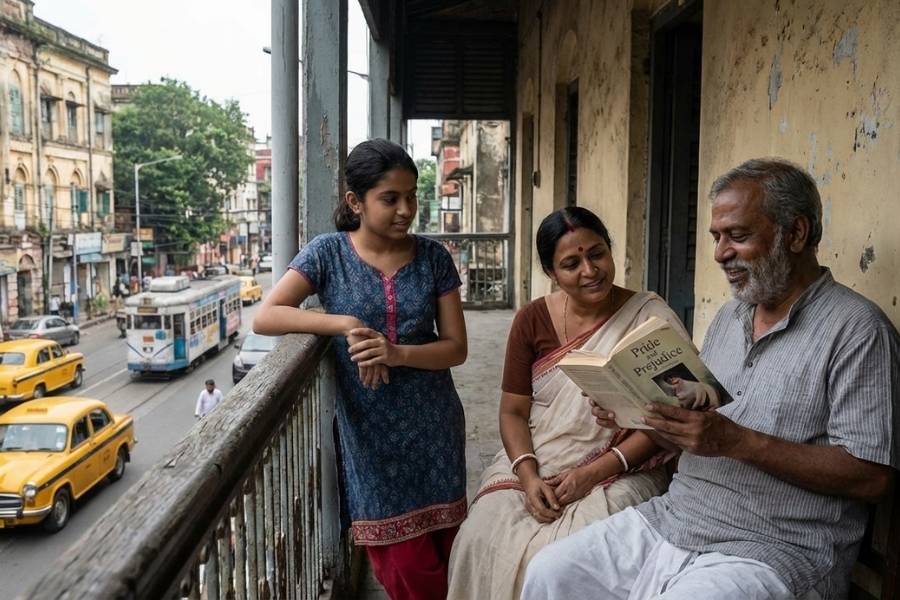
Did you know American reality television star Kourtney Kardashian starts her day with a teaspoon of warm ghee? Or that Shilpa Shetty uses two spoons of ghee in her food? Stars like Kareena Kapoor and Saif Ali Khan have long been avid fans.
Yes, ghee’s making a comeback. It’s always been an integral part of Indian culture, cuisine and Ayurveda. Over the last 60 years, however, it has been reviled as an unhealthy fat that was full of cholesterol as urban Indians switched to refined vegetable oils. But all that is changing now. With Western nutrition science catching up with ancient Indian food wisdom to prove its many benefits, ghee is making a big splash across the world.
.jpg)
Photo: Rupinder Sharma
“The whole attitude to ghee is going through a dramatic change,” says celebrity nutritionist Rujuta Diwekar, a voluble champion of the superfood. So, urban Indians are starting to lose their scepticism about ghee even as premium, organic cow’s ghee brands like Organic India, the Holy Cow Foundation with its ahimsak ghee, and
Vedic Cow Products are churning the market.
“The last 60 years’ brainwashing about ghee hasn’t gone entirely but there’s a lot of interest in it. As more
information reaches people, they’re making intelligent choices,” says Diwekar.
.jpg)
PHOTOS COURTESY: PURE INDIAN FOODS
.jpg)
Leading nutritionist Shikha Sharma too says: “The new generation is looking at ghee more positively.” And animal activist Anuradha Modi, who founded the Holy Cow Foundation to help sustain desi cows, adds: “People have seen the ill effects of vegetable oils. So, they’re returning to our traditional foods.”
.jpg)
Across the globe, too, ghee’s finding numerous takers with local ghee brands springing up from the US to the UK to Australia. Chef Kunal Kapur recalls stumbling upon a ghee stall at a Sydney farmer’s market last year. “It was most unexpected but they’d had Indian ghee so they started making it,” he recounts.
In the US, celebrity chefs like Alton Brown and Michel Richard are using ghee — Brown even tweeted on how to make it at home. It’s also getting huge mileage from the trendy Paleo diet, which is based on how our hunter-gatherer ancestors ate and so is high in fat. And lovers of the popular Bulletproof Coffee and also of Turmeric Latte (it’s a variant of our haldi doodh), which is the drink du jour from Sydney to San Francisco, are having them with a dash of ghee.
“Ghee has become big in the US as people are moving towards natural foods,” says New Jersey-based Sandeep Agarwal, who quit his Wall Street job to spread the benefits of ghee with his Pure Indian Foods. It’s among the top-selling organic ghee brands on Amazon. And, given Western food preferences, he has even introduced spice-infused variants like Italian Ghee, Herbes de Provence Ghee and his latest, Coconut Ghee.
Meanwhile, in India, Baba Ramdev’s Patanjali Ayurved has helped churn ghee’s fortunes with cow’s ghee sales rising rapidly. So, Parag Milk Foods’ Gowardhan ghee’s sales are growing at 20 per cent. “Ghee’s a growth driver for us,” says Shirish Upadhyay, vice president, strategic planning, Parag Milk Foods. Also, Amul ghee’s sales grew about 30 per cent in 2015-16. And ITC launched its Aashirwad ghee last year.
.jpg)
PHOTO COURTESY CHEF KUNAL KAPUR
And, with creamy layer, health-conscious Indians going organic, premium brands like Organic India, Holy Cow and Vedic Cow Products are flying off the shelves too despite their higher prices. Holy Cow’s ghee is priced at
Rs 1,600 a kg against Amul’s at Rs 390. “Our ghee is ahimsak as the goshala focuses on cow welfare so male calves are not abandoned,” says Modi.
Avani Davda, managing director, Godrej Nature’s Basket, says: “There’s an increase in the number of customers buying ghee.” Its ghee sales have risen from Rs 55 lakh two years ago to Rs 95 lakh today. It stocks eight ghee brands like Sanjeevani Organics and Amira. “A larger number of organic brands are coming to our stores and demand for them has been higher too,” says Davda.

So why’s ghee good for you? It’s generally accepted now that the 1980s’ low-fat prescription was misleading and that it’s a myth that saturated fats push up blood cholesterol and clog arteries. Rather, recent studies say that low-fat diets high in refined carbohydrates and sugars are linked to diseases. Even the USFDA removed the link between dietary cholesterol and heart disease last year.
.jpg)
Photo: Gajanan Dudhalkar
So, saturated fats from natural sources like ghee, which Diwekar calls a “super-fat”, are good. That’s because of several properties. For one, ghee’s rich in short-chain fatty acids (SCFA), which help to maintain gut bacteria. This makes it lipolytic, that is, it breaks down fat and so helps in losing weight. It’s also rich in butyrate, an SCFA that promotes colon health, so it is detoxifying and anti-inflammatory.
Then, it’s packed with fat-soluble Vitamins A, D, E and K. Also, ghee made from grass-fed cows’ milk has conjugated linoleic acid or CLA, an antioxidant that can help fight cancers. “Many Ayurvedic medicines use ghee as a transporter,” says Sharma.
Agarwal points out that ghee has an Omega 6:Omega 3 ratio of only two — a ratio of below 4 is best — which makes it anti-inflammatory. And Diwekar says that when added to a meal, ghee reduces its glycemic index, thus regulating blood sugar. It’s also safe for those who’re lactose- and casein-sensitive as milk solids are removed when butter is heated to make ghee. Plus, it has a high smoke point.
No wonder, organic cow’s ghee is finding so many takers. Take Agarwal’s Pure Indian Foods. His family’s been in the ghee business in Hissar for five generations. But Agarwal, who moved to the US as a techie in 1994, only turned to traditional foods after his son had health problems at six months in 2002. “My interest grew in the Indian value system. So, I started to read. And I began to connect the dots between what’s written in our scriptures and Ayurveda and scientific papers,” he says.
His family switched to eating fresh foods and his wife, Nalini, began making ghee at home. By 2004, their health improved hugely. So in 2007-08, they decided to “spread the benefits of ghee” and began making it in small batches.
Surprisingly, their first customers were Westerners “looking for the benefits of grass-fed dairy products”. “It was the start of the organic movement, so our timing was perfect,” says Agarwal. The word spread and by 2010, he quit his Wall Street job. “I haven’t looked back since,” he says. His sales are growing by 25 per cent today and Nalini still makes the ghee herself from spring to fall, when cows are grass-fed there.
Back home in India too, the premium’s on ghee from grass-fed cows. Take Organic India, which was founded by Israeli Yoav Lev in 1997. It launched organic ghee five years ago. “We started with 500 bottles a month and it was a struggle to sell. But as the audience for organic products grew, there was a shift,” says Saurabh Tiwari, marketing head, Organic India. In 2015-16, its ghee sales touched Rs 5 crore. “The demand is three times our supply,” says Tiwari, who’s adding capacity now.
Meanwhile, Vedic Cow Products and Holy Cow are focusing on quality over quantity. “I think we need a Project Cow to save the desi cow,” says Modi, whose Holy Cow is helping to sustain them by selling products based on cow dung and urine.
Mumbai-based techie Nishant Khadria set up Vedic Cow Products three years ago as “a platform for people who want to connect with our traditional values”. He says he was always interested in feeding cows as a child. But he realised that few people can give up their urban lifestyle. So he has got them to support desi cows by buying their by-products.
.jpg)
.jpg)

Khadria currently sells ghee made by a farm in Maharashtra for Rs 1,300 a kg. “I taste every batch to ensure quality,” he says. His sales are growing by nearly 30 per cent and he’s even got customers abroad. “People in the US and Australia are crazy about our ghee. We don’t have enough stocks. But the only thing I’m worried about is quality,” he says.
Meanwhile, Holy Cow’s ghee is made by a goshala in Gujarat. “We only sell 20kg a month but the demand is high,” says Modi. A customer recently took 400g packs as return gifts for a baby shower. “It’s expensive. So we tell people to use it raw, on their roti or dal,” she says.
Of course, Indians don’t need lessons on using ghee. Chef Kapur says: “I use it when I do these very classic dishes.” Like parathas. He also loves using it in jalebis. “Jalebis fried in oil are just not the same,” he says.
But he admits that Westerners are really “breaking the mould” and experimenting, spreading ghee on toast and cooking seafood in it. Agarwal even got chefs to create ghee recipes for Americans. “They love to cook eggs in it,” he says. He recommends the USFDA portion of a tablespoon of dairy fat per meal.
But Sharma only recommends one teaspoon a day for the overweight and two for the rest. “Ayurveda prescribes ghee in small amounts,” she says. Diwekar says that very young and very old people need more ghee as it’s therapeutic. And you need more ghee in winter than in summer.
Says Diwekar: “We switched from ghee because we blindly copied Western nutrition science. So cardiologists and diabetologists in India said that ghee is bad. Now that the science they’re guided by has changed, I hope they’ll also change their advice.” Well, the new advocates of ghee are spreading the word.











